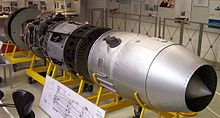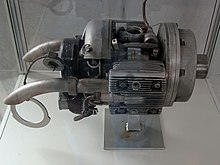Junkers Jumo 004

The Junkers Jumo 004 was the world's first jet engine ready for series production . From February 1944 to March 1945, 6010 Jumo-004 units of the series versions B1 and B2 were produced, of which 4752 units were delivered. These were mainly used for the Messerschmitt Me 262 and the Arado Ar 234 . The construction of the Junkers Flugzeug- und Motorenwerke was produced and used in further developed variants in some Eastern European countries even after the war.
Development history
The possible uses and advantages of the “new type of aircraft drive” were demonstrated in Germany as early as 1939 by Hans von Ohain , who was employed as a developer at the Heinkel aircraft factory. This happened for the first time with a test flight of the single-engine Heinkel He 178 on August 27, 1939, but not with a Jumo 004, but with a Heinkel HeS 3 . However, the Reich Aviation Ministry (RLM) showed no interest in the new technology, and no representative from the RLM appeared at this demonstration. Hermann Göring as Reich Aviation Minister and Ernst Udet - General Air Force Master and thus Head of Technical Development in the Air Force - did not recognize the possibilities of the new technology. This changed with Erhard Milch , his successor after Udo's suicide in November 1941. The forced development of jet engines should now provide the Air Force with decisive advantages.
Junkers engine construction in Dessau then began under the direction of Anselm Franz with the development of a reliable jet engine that was ready for series production. The RLM gave this project the number 109-004, from which the name of the jet engine Jumo 004 (JUnkers MOtor + project number) is derived. All top secret developments of jet engines and rocket propulsion got the inconspicuous prefix "109" (see also: Walter HWK 109-509 ).
The prototype of the Jumo 004A was first tested in late 1940. In the following January, the jet engine was able to be accelerated to full thrust without any malfunctions or engine bursts. However, the use in an airplane was delayed because there were repeated problems with the compressor blades . In March 1942 it could be used for the first time on a Messerschmitt Bf 110 for flight tests. On July 18, 1942, the Jumo 004 engine was first successfully used in a prototype of the twin-engine Messerschmitt Me 262 .
The RLM then ordered the engine as equipment for the new generation of aircraft. The Jumo 004 and components were built in the plants in Dessau, Magdeburg and Köthen , the two Junkers subsidiaries Zittwerke AG in Zittau and Muldenwerke AG in Muldenstein and at the Mitteldeutsche Motorenwerke GmbH in Taucha , which belongs to the Auto-Union group .
The engine had to be redesigned in order to reduce the use of scarce “fuel”, especially nickel and molybdenum . Many parts were now made from deep-drawn sheet metal that was coated with aluminum paint to protect against scaling . Instead of Tinidur (30% nickel, 15% chromium and 1.7% titanium), Chromadur without nickel with 13% chromium, 18% manganese and 0.7% vanadium was used for the turbine blades . After the fourth compressor stage, cooling air was branched off for the thrust nozzle housing; the air for cooling the turbine guide vanes and the hollow rotor blades branched off after the eighth stage of the compressor. To avoid vibration problems with the blading, the maximum speed of the engine was reduced from 9000 min −1 to 8700 min −1 . These changes resulted in a loss of power - the Jumo 004 A still delivered 9.8 kN (1000 kp) of thrust, while the 004 B, as a “fuel-efficient” engine, only had 8.7 kN (890 kp) of thrust. The weight of the Jumo 004 B has been reduced by around 100 kg compared to the A version. Despite the complex cooling system of the new "sheet metal turbine" Jumo 004 B, these were not able to withstand the mechanical and thermal loads in the long term without "savings" and often caused problems with cracked guide or impeller blades. While the previous model, the Jumo 004 A, withstood 100-hour full-load runs without any problems, the time period for the major overhaul had to be reduced to 25 hours for the series Jumo 004 B. In use, the 004-B engines were often damaged before that time. The service life of the engines depended not insignificantly on the experience of the respective pilot. Opening the power regulator too quickly often led to overheating and damage to the turbine.
For starting up the engine to cranking speed in the hub of the engine inlet, a 2-cylinder was two-stroke - Boxer engine installed with extremely short stroke of the electrically or with a pull starter was started. The engine ("Riedel starter") designed by Norbert Riedel with a displacement of 270 cm 3 had an output of 7.7 kW (10.5 hp) at a speed of 7150 min −1 and was manufactured by the Victoria works in Nuremberg .
At that time, the engines were called “turbo” in the short form of turbine, which is derived from the Latin turbo, turbonis (whirlwind, something rotating). In English usage, the term “turbojet” is still common today as a generic name for single- flow jet engines without bypass flow .
A special feature of the Jumo 004 and BMW 003 turbines was that they were already equipped with axial compressors . The British jet engines of the type Rolls-Royce Welland , Derwent and Nene had radial compressors, whereby the engines had a much larger diameter. The axial compressor was only used in 1947 in the Rolls-Royce Avon and in the same year in the General Electric J35 and is now generally state of the art.
Technical specifications
| Parameter | Jumo 004 B-1 "Hurricane" |
|---|---|
| compressor | 8-stage axial |
| turbine | 1-stage axial |
| Compressor pressure ratio | 3.1: 1 |
| Weight | 757 kg |
| Weight with fairing | 805 kg |
| Standing thrust | 8.7 kN |
| Idle speed | 3080 min −1 |
| Max. rotational speed | 8700 min -1 |
| Idle consumption | 283 kg / h |
| Max. Fuel consumption | 1234 kg / h |
| spec. Fuel consumption | 138.7 kg / kNh |
| largest outside diameter | 0.86 m |
| length | 3.86 m |
| Face | 0.59 m² |
use
- Messerschmitt Me 262
- Arado Ar 234
- Heinkel He 280 V7, V8
- Heinkel He 162
- Junkers Ju 287 V1
- Arsenal VG 70-01
- SNCASO 6000 J-01 Triton
- Hoarding Ho 9 IX V2
- Yakovlev Yak-15
- Lavochkin La-150
- Sukhoi Su-9
Museum reception
Copies of the Jumo 004 or its cutaway models are today in the Hugo Junkers Technology Museum in Dessau, the L. + P. Junior in Hermeskeil , the Aviation Museum in Laatzen , the RWTH Aachen , the Messerschmitt Flight Museum in Manching, the TU Darmstadt , the Army History Museum in Vienna , the Musée de l'air et de l'espace in Le Bourget , the Science Museum in London , the National Museum of the United States Air Force in Dayton and the Museum of the Swiss Air Force in Dübendorf (Zurich).
See also
Web links
Individual evidence
- ↑ von Gersdorff, Grasmann: Die deutsche Luftfahrt , Volume 2: Flugmotoren und Strahltriebwerke, Bernard & Graefe Verlag Munich 1981, ISBN 3-7637-5272-2 , p. 209.


